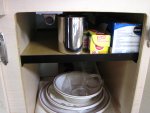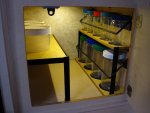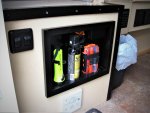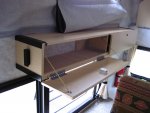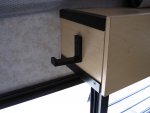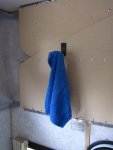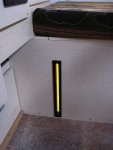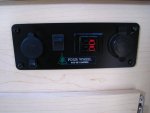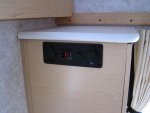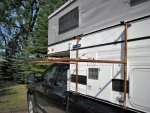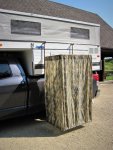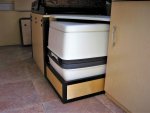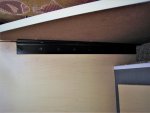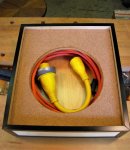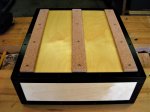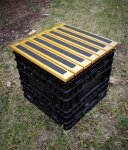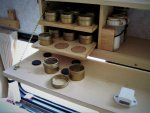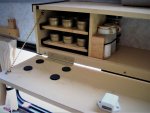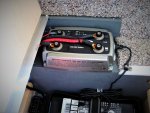White Dog
Member
I admit it; I'm an compulsive tinkerer. On every trip, whether it is a weekend or 2 months, I make a list of 'improvements' I think I need to make to my Fourwheel Camper or Toyota pickup. I think it is a passion. My wife jokingly calls it my obsession. And its not my only one I'm afraid. The 'improvements' have been going on since we bought the camper new from the Canadian distributor back in 2012. I think the list is getting shorter. Maybe I'm just writing smaller.
A thread on this forum has been going on for a while concerning the dated technology of the FWC fleet. Personally, my view is update-when-necessary otherwise leave it alone. Others would and have disagreed. That's great. Open respectful discussions should always be encouraged. That thread got me thinking it might be worth sharing my tinkerings with our FWC. Face it, no manufacturer can make the perfect camper (or anything else) for everyone or anyone for that matter. Each owner invariably wants modifications that will make the camper work better for them. Sometimes these aren't just little tweaks either. The point of this thread is to illustrate those that I have made and will be making, discuss why I made them and hopefully encourage others to ask questions and make different suggestions that solve the same need.
I need to start by introducing my camper and truck.
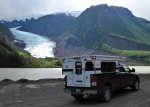
The camper is a 2012 Fourwheel Camper 'Grandby' bought new. My wife was all for it as long as she got to pick some of the options that she felt would make her life more comfortable. Fair enough! One of the features we liked about FWCs was the ability to order options a la carte. By the time the order went in, not many of the check-off option boxes were empty. Again, fair enough. The truck is a 2011 Toyota Tundra, also bought new. It is the extended cab long box model which makes for a total length of nearly 21'. We thought this may be a bit of a drawback but it really hasn't. Technical off-roading isn't our thing but we aren't shy about heading down two-tracks either. The truck has the 5.7 l V8 with the six speed automatic. The engine has lots of power and has a proven reliability record. While I think I prefer standard transmissions, the automatic in this truck is excellent. The shift points seem to be in just about the right places and the tap-shifting options lets me drive it essentially as a standard just without a clutch. So far, we have put about 60,000 km on the truck/camper and spent close to 6 months on the road with the rig. We have had absolutely no mechanical issues with either the truck or camper. In the offseason, the camper lives in a shed out of the rain/snow and sun. The truck goes back to civilian life helping me with my retirement business.
When we first started planning our Overlanding life, we decided we wanted a rig that we could be totally self sufficient in for at least 7 days: no grocery shopping, no water resupply, no propane fills, no laundry, no public showers. We also wanted to have a minimum range of 700 km without refueling. We have been able to achieve these goals. When we stock up for a long unsupported bit, we put the fruit and veg in a Yeti cooler in the back seat of the truck along with a bag of ice. The meat and more fragile perishables go in the Dometic compressor fridge. By the time the ice melts in the Yeti cooler (~5 days) there is room for the last of the fruit and veg in the fridge. To keep the house batteries charged while we aren't driving, I have put 2 X 100w solar panels on the roof of the camper. The idea was to reserve the propane for heating, cooking and making hot water. If we ran out of propane, the compressor fridge would still run preserving our food. This has sort of worked out but as you will see in future postings, it has been troublesome. An acquaintance who works in the industry once told me: "The Dometic compressor fridge is a great idea just poorly executed". If I'm travelling alone, the 75 l onboard water tank is enough to keep me going for the 7 days. If my wife is along, we carry 2 X 20 l Gerry cans in the back seat of the truck. That has worked out fine. The one drawback of the Tundra is its small 100 l fuel tank (current models have 140 l tanks). I can usually get 600 km out of the tank if I drive very carefully. I always carry an empty 20 l fuel Gerry can which I fill if I suspect I am going to be stretched for fuel. This gives me close to the 700 km I was after.
I think I will start by doing a posting for each of the groups of personalization projects I have already completed then do a bit more detailed series of entries with the ones I am currently working on. I'll see how it goes. Give me your thoughts and suggestions. They aren't just for me but for all those tinkering with their campers.
A thread on this forum has been going on for a while concerning the dated technology of the FWC fleet. Personally, my view is update-when-necessary otherwise leave it alone. Others would and have disagreed. That's great. Open respectful discussions should always be encouraged. That thread got me thinking it might be worth sharing my tinkerings with our FWC. Face it, no manufacturer can make the perfect camper (or anything else) for everyone or anyone for that matter. Each owner invariably wants modifications that will make the camper work better for them. Sometimes these aren't just little tweaks either. The point of this thread is to illustrate those that I have made and will be making, discuss why I made them and hopefully encourage others to ask questions and make different suggestions that solve the same need.
I need to start by introducing my camper and truck.

The camper is a 2012 Fourwheel Camper 'Grandby' bought new. My wife was all for it as long as she got to pick some of the options that she felt would make her life more comfortable. Fair enough! One of the features we liked about FWCs was the ability to order options a la carte. By the time the order went in, not many of the check-off option boxes were empty. Again, fair enough. The truck is a 2011 Toyota Tundra, also bought new. It is the extended cab long box model which makes for a total length of nearly 21'. We thought this may be a bit of a drawback but it really hasn't. Technical off-roading isn't our thing but we aren't shy about heading down two-tracks either. The truck has the 5.7 l V8 with the six speed automatic. The engine has lots of power and has a proven reliability record. While I think I prefer standard transmissions, the automatic in this truck is excellent. The shift points seem to be in just about the right places and the tap-shifting options lets me drive it essentially as a standard just without a clutch. So far, we have put about 60,000 km on the truck/camper and spent close to 6 months on the road with the rig. We have had absolutely no mechanical issues with either the truck or camper. In the offseason, the camper lives in a shed out of the rain/snow and sun. The truck goes back to civilian life helping me with my retirement business.
When we first started planning our Overlanding life, we decided we wanted a rig that we could be totally self sufficient in for at least 7 days: no grocery shopping, no water resupply, no propane fills, no laundry, no public showers. We also wanted to have a minimum range of 700 km without refueling. We have been able to achieve these goals. When we stock up for a long unsupported bit, we put the fruit and veg in a Yeti cooler in the back seat of the truck along with a bag of ice. The meat and more fragile perishables go in the Dometic compressor fridge. By the time the ice melts in the Yeti cooler (~5 days) there is room for the last of the fruit and veg in the fridge. To keep the house batteries charged while we aren't driving, I have put 2 X 100w solar panels on the roof of the camper. The idea was to reserve the propane for heating, cooking and making hot water. If we ran out of propane, the compressor fridge would still run preserving our food. This has sort of worked out but as you will see in future postings, it has been troublesome. An acquaintance who works in the industry once told me: "The Dometic compressor fridge is a great idea just poorly executed". If I'm travelling alone, the 75 l onboard water tank is enough to keep me going for the 7 days. If my wife is along, we carry 2 X 20 l Gerry cans in the back seat of the truck. That has worked out fine. The one drawback of the Tundra is its small 100 l fuel tank (current models have 140 l tanks). I can usually get 600 km out of the tank if I drive very carefully. I always carry an empty 20 l fuel Gerry can which I fill if I suspect I am going to be stretched for fuel. This gives me close to the 700 km I was after.
I think I will start by doing a posting for each of the groups of personalization projects I have already completed then do a bit more detailed series of entries with the ones I am currently working on. I'll see how it goes. Give me your thoughts and suggestions. They aren't just for me but for all those tinkering with their campers.

